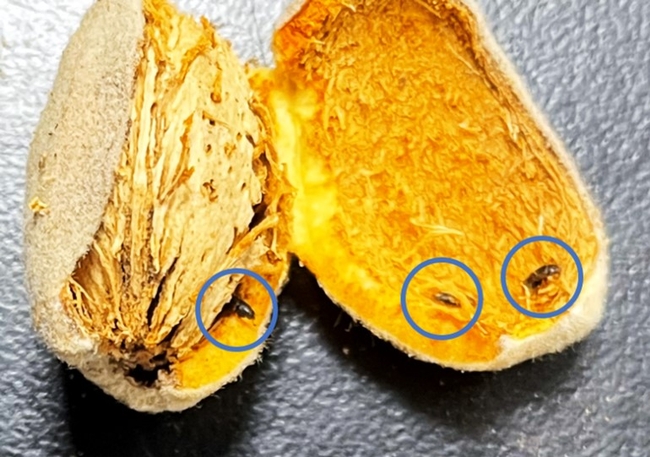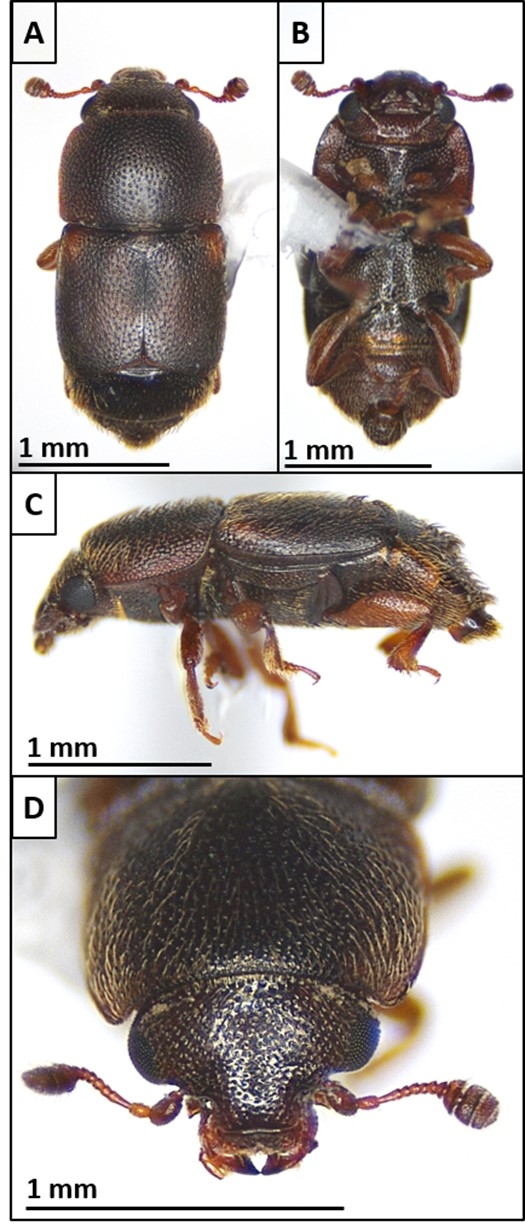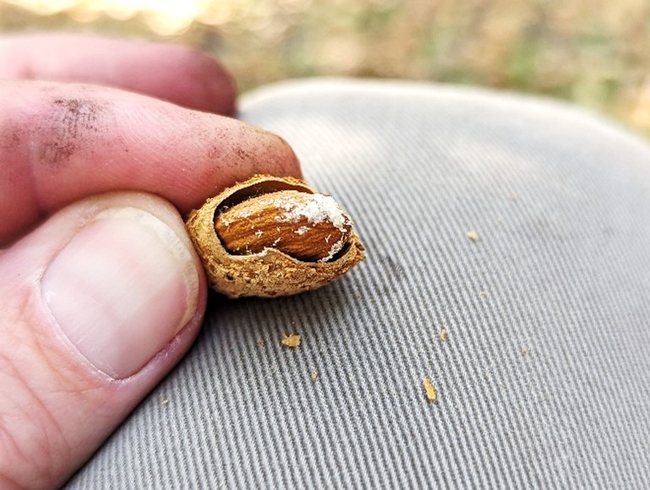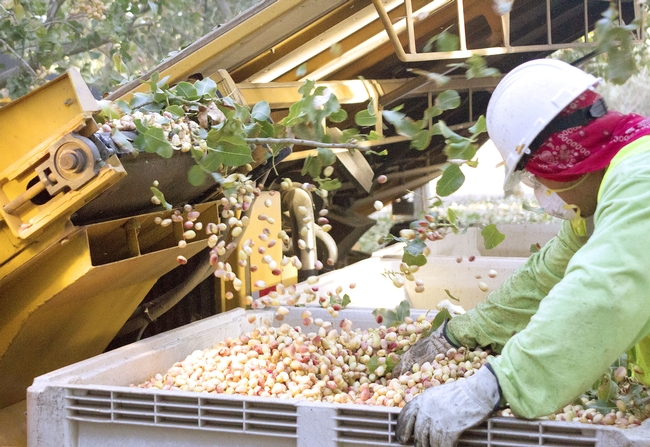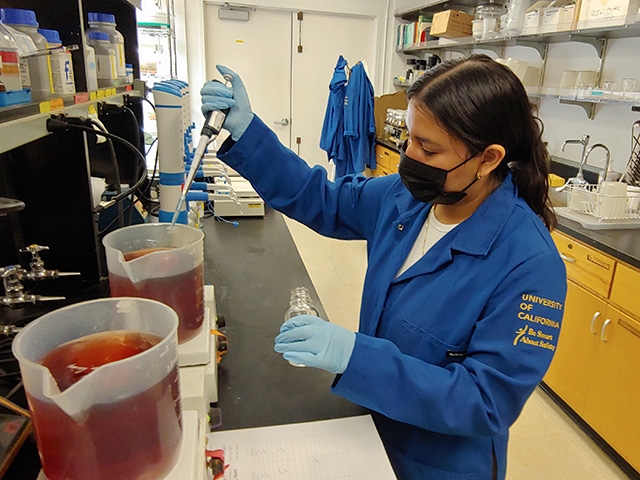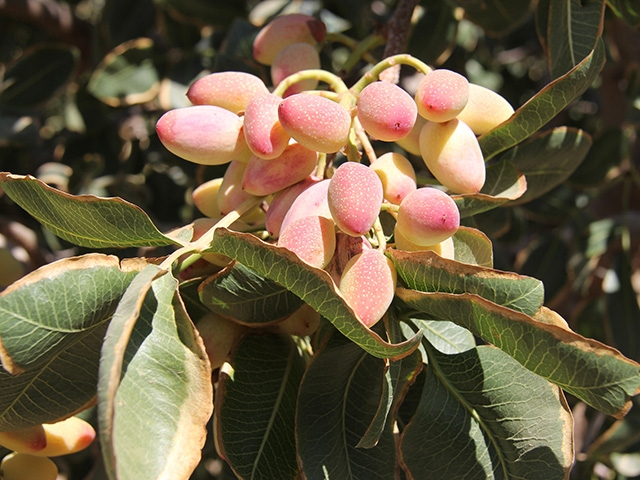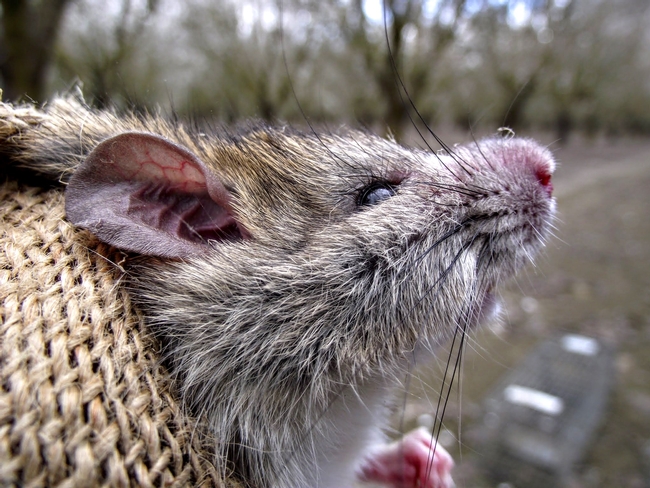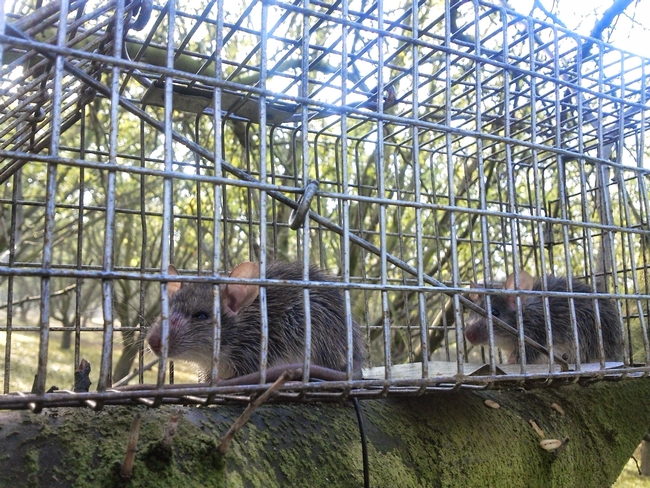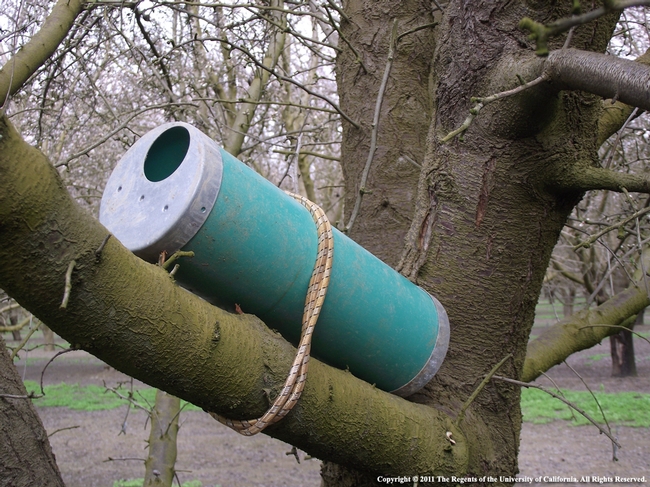
Posts Tagged: Pistachio
New pest infesting almonds and pistachios in the San Joaquin Valley
Crop sanitation will be key to controlling the invasive carpophilus beetle
Growers and pest control advisers (PCAs) should be on the lookout for a new pest called carpophilus beetle (Carpophilus truncatus). This pest was recently found infesting almonds and pistachios in the San Joaquin Valley, and is recognized as one of the top two pests of almond production in Australia. Damage occurs when adults and larvae feed directly on the kernel, causing reductions in both yield and quality.
Populations of carpophilus beetle were first detected in September in almond and pistachio orchards by University of California Cooperative Extension Specialist Houston Wilson of UC Riverside's Department of Entomology. Pest identification was subsequently confirmed by the California Department of Food and Agriculture.
Wilson is now working with Jhalendra Rijal, UC integrated pest management advisor, North San Joaquin Valley; David Haviland, UCCE farm advisor, Kern County; and other UCCE farm advisors to conduct a broader survey of orchards throughout the San Joaquin Valley to determine the extent of the outbreak.
To date, almond or pistachio orchards infested by carpophilus beetle have been confirmed in Stanislaus, Merced, Madera and Kings counties, suggesting that the establishment of this new pest is already widespread. In fact, some specimens from Merced County were from collections that were made in 2022, suggesting that the pest has been present in the San Joaquin Valley for at least a year already.
“It has likely been here for a few years based on the damage we've seen," Rijal said.
This invasive beetle overwinters in remnant nuts (i.e. mummy nuts) that are left in the tree or on the ground following the previous year's harvest. Adults move onto new crop nuts around hull-split, where they deposit their eggs directly onto the nut. The larvae that emerge feed on the developing kernels, leaving the almond kernel packed with a fine powdery mix of nutmeat and frass that is sometimes accompanied by an oval-shaped tunnel.
Carpophilus beetle has been well-established in Australia for over 10 years, where it is considered a key pest of almonds. More recently, the beetle was reported from walnuts in Argentina and Italy as well. Carpophilus truncatus is a close relative to other beetles in the genus Carpophilus, such as the driedfruit beetle (C. hemipterus) that is known primarily as a postharvest pest of figs and raisins in California.
Monitoring for carpophilus beetle is currently limited to direct inspection of hull split nuts for the presence of feeding holes and/or larvae or adult beetles. A new pheromone lure that is being developed in Australia may soon provide a better monitoring tool for growers, PCAs and researchers.
“We're lucky to have colleagues abroad that have already been hammering away at this pest for almost a decade,” said Haviland. “Hopefully we can learn from their experiences and quickly get this new beetle under control.”
The ability to use insecticides to control carpophilus beetle remains unclear. The majority of the beetle's life cycle is spent protected inside the nut, with relatively short windows of opportunity available to attack the adults while they are exposed. The location of the beetles within the nut throughout most of their life cycle also allows them to avoid meaningful levels of biological control.
In the absence of clear chemical or biological control strategies, the most important tool for managing this beetle is crop sanitation.
“Given that this pest overwinters on remnant nuts, similar to navel orangeworm, crop sanitation will be fundamental to controlling it,” Wilson said. “If you needed another reason to clean up and destroy mummy nuts – this is it.”
In Australia, sanitation is currently the primary method for managing this pest. And here in California, new research and extension activities focused on carpophilus beetle are currently in the works.
“It's important that we get on top of this immediately,” said Wilson. “We're already starting to put together a game plan for research and extension in 2024 and beyond.”
If you suspect that you have this beetle in your orchard, please contact your local UC Cooperative Extension farm advisor (https://ucanr.edu/About/Locations/), County Agricultural Commissioner (https://cacasa.org/county/) and/or the CDFA Pest Hotline (https://www.cdfa.ca.gov/plant/reportapest/) at 1-800-491-1899.
First look at controlling alkaliweed
Pistachio production has been expanding, particularly into marginal soils with high salts, boron, and even sodic conditions. One plant that is endemic to these conditions, alkaliweed, has been reported in these orchards. While there have been some articles suggesting that it it is a new weed to...
NIFA funds $3.8 million project to find climate-resilient pistachio trees
Growers invited to participate in study by sharing their experiences
A multi-state team led by Patrick J. Brown has been awarded nearly $3.8 million over the next four years for a project to improve pistachio production as the industry faces warmer winters and scarcer water.
“We are at this unique point in history where we can do this,” said Brown, an associate professor in the UC Davis Department of Plant Sciences.
The project aims to ensure the industry can thrive in coming decades despite the challenges faced. Growers are invited to participate in the study, sharing what they already are trying in their own fields or supporting any aspect of the project. To discuss the possibilities, contact Brown at pjbrown@ucdavis.edu or (530) 752-4288.
The project includes research to ensure pollination, experiments to calculate irrigation needs amid water shortages, creating tools to improve public breeding programs, developing more efficient harvesting equipment, and economic analyses to ensure future pistachio cultivation is economically rewarding. Researchers hope to offer a guide for growers deciding whether to plant new orchards or remove existing ones.
“The success of California's pistachio industry, which is the top producer of the nuts in the world, has always relied on a strong collaboration between UC researchers and pistachio growers,” said project participant Florent Trouillas, a UC Cooperative Extension specialist in the UC Davis Department of Plant Pathology. “Research efforts must continue to address enduring and new challenges, improve sustainability and ensure the profitability of pistachio farming.”
The tasty, green nuts have blossomed into a $5.2-billion industry in California, thanks to their greater tolerance of dry lands and salty soils. The project aims to further improve their climate resilience by finding a rootstock that can thrive despite growing water scarcity and declining water quality projected over the next half-century. With millions of genetically distinct pistachio trees growing in the state, "we already have out there what may be the industry's next great rootstock," Brown said. "It's probably in some grower's field already. We just have to find it."
Researchers seek to pair that new rootstock with high-yielding scions – the producing part of the tree grafted onto the rootstock – to develop new combinations that can thrive in the different conditions across the state.
Trouble with “boy meets girl”
Pistachios, like many other tree crops, have male and female trees, and they require hundreds of hours of wintertime temperatures below 45 degrees Fahrenheit for the trees to flower in the spring. Wind blows the pollen from male flowers to female flowers, creating nuts.
Complicating the timing: Boy flowers and girl flowers generally require different amounts of winter cold to bloom. After a sufficiently cold winter, boys and girls flower together. But if the winter is warm, most of them will flower at different times, reducing pollination.
That happened in the winter of 2014-15, which saw unusually warm winter temperatures. The following fall, farmers harvested only half their expected crop, losing more than $1 billion, Brown said. Climate change is expected to provoke progressively warmer winters in the future, on average.
An additional complication: The boy scions come from a single variety, or cultivar, and the girl scions come from another single cultivar. "In California part of the problem is that we have been relying on a single male and single female cultivar," Brown explained.
A key part of this project will be to test new scions that can pollinate efficiently despite warmer winters. “We now have additional male and female scions released in the last 10 to 15 years, but we need more information on their chill requirements,” Brown said.
Growing importance of pistachio sector
With nearly 520,000 acres planted in California in 2021, pistachios are the fastest-growing tree nut crop in the state. Growers have doubled their plantings over the past decade, due to pistachios' drought tolerance and higher gross returns compared to other nuts, experts report. California dominates the industry, growing 99 percent of the nation's crop and nearly 60 percent of the world's crop, employing people in 47,000 full-time-equivalent jobs and creating $5.2-billion of total economic impact in 2020, according to American Pistachio Growers.
Brown's team is part of a wider effort at UC Davis to support the sector's growth and adaptation to climate change. Other department members participating in the project include co-directors Louise Ferguson, a UC Cooperative Extension pomologist, and Richard W. Michelmore, a distinguished professor and director of the UC Davis Genome Center. Also participating are Giulia Marino, a UC Cooperative Extension specialist; and Grey Monroe, an assistant professor.
Other UC Davis participants include Trouillas and Brittney Goodrich, a UC Cooperative Extension specialist in the Department of Agricultural and Resource Economics. The project also includes researchers from UC Merced, New Mexico State University and Purdue University.
The four-year project was among nearly $70 million in Specialty Crop Research Initiative grants awarded this fall by the National Institute of Food and Agriculture. The Department of Plant Sciences landed three of the 25 grants.
Read the NIFA grant summary.
Roof rats unnerve farm workers, damage orchard crops
Monitor for rodent activity and use bait stations before the growing season to prevent problems, UC ANR scientists recommend.
Roof rats are running rampant in California orchards this year, according to UC Agriculture and Natural Resources scientists.
“In pistachio and other nut orchards, roof rats are burrowing and nesting in the ground where they're chewing on irrigation lines, causing extensive damage,” said Rachael Long, UC Cooperative Extension advisor. “They are also nesting in citrus trees, feeding on the fruit and terrifying field workers when they jump out as people are picking fruit. The chewing pests are also girdling citrus limbs, causing branch dieback.”
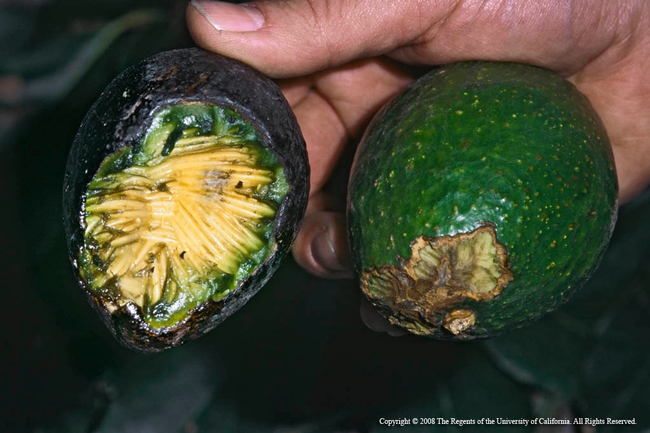
Holes in the ground around the base of pistachio trees throughout a Yolo County orchard puzzled the grower.
“We looked for ground squirrels, but never saw any,” Long said. “We set up game cameras, but only got birds and rabbits. We put rodent bait in the holes, but the digging didn't stop.”
Long, the pest detective, cracked the case by consulting Niamh Quinn, UC Cooperative Extension human-wildlife interactions advisor based in Irvine. “She informed us that the damage we were seeing was from roof rats.”
Burrowing roof rats sounds like an oxymoron. While roof rats generally don't burrow in urban environments, their country cousins have been known to burrow.
“It's not true that they don't burrow,” Quinn said. “When I worked as staff research associate for Roger Baldwin, UC Cooperative Extension wildlife specialist, that is mostly what we studied, burrowing roof rats in orchards.”
Control measures
Baldwin said, “It seems to be a good year for rats in a number of different areas and crops throughout the state. I've received more questions and comments about rats this year than perhaps the last 10 years combined. As for bait application, putting bait down burrow systems for rats doesn't usually work too well, so I'm not surprised that approach didn't work. Growers will likely have better luck with bait stations in the trees.”
Because the rats climb, Baldwin suggests attaching bait stations to tree branches.
“In addition, elevating the bait stations will eliminate access to bait for many protected mammal species, such as kangaroo rats,” Long said. “The bait diphacinone grain can be purchased from some ag commissioners' offices. This is what Roger Baldwin said they tested and it worked.”
As for the bait stations, they should be designed so that there isn't any spillage for nontarget animals to eat, Long said.
When roof rat outbreaks occur, rodenticides are often needed to prevent crop damage. However, timing is critical as diphacinone use is highly restrictive and not allowed during the growing season, which is beginning as the weather warms.
“Check the product label for application instructions,” Long reminds growers. “It's the law.”
Identifying the pest
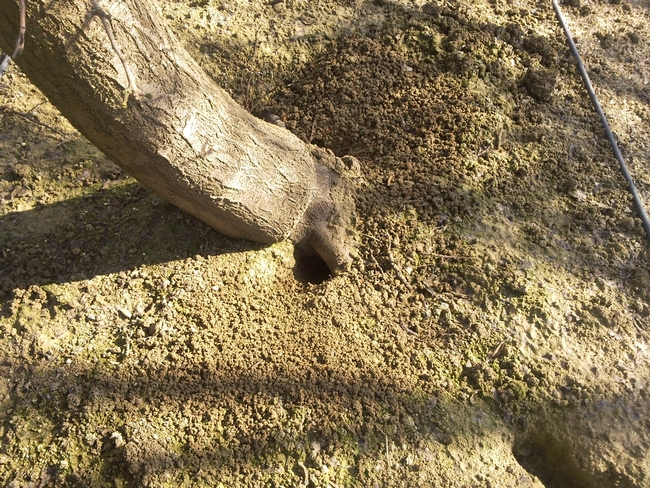
“Roof rats can forage away from their nest, so you won't likely find signs of their activity, such as rat droppings outside their burrow, to help identify them,” Long said.
Ground squirrels are active during the day, so they are more likely to be seen, dig holes about 4 inches in diameter and forage above ground near their burrows. Vole and mouse holes are 1- to 2-inches in diameter. Roof rat holes are typically 3 to 4 inches in diameter and might have nut shells in front of them, for example pistachio or almond shells. Rabbits will feed on seedling crops, but do not dig burrows.
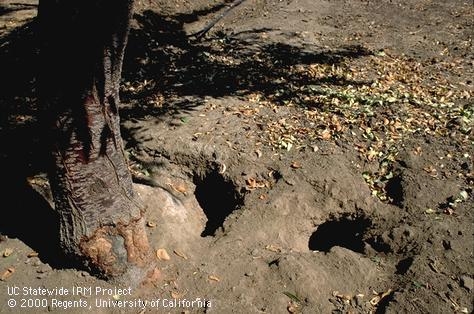
“Rats are sneaky and hard to spot,” Long said. “If you see damage, including digging in the soil but no wildlife, suspect rats.”
For more information on controlling roof rats, download Quinn and Baldwin's free UC ANR publication 8513, Managing Roof Rats and Deer Mice in Nut and Fruit Orchards at http://anrcatalog.ucanr.edu/Details.aspx?itemNo=8513.
For more information about ground squirrels, download the free UC IPM Best Management Guidelines http://www.groundsquirrelbmp.com or UC IPM Pest Note http://ipm.ucanr.edu/PMG/PESTNOTES/pn7438.html.
Pistachio industry targets navel orangeworm with sterile moths

The same approach was used in a long-running battle with pink bollworms, which used to be the bane of cotton farmers. The story said USDA is checking fields this year before declaring pink bollworm officially eradicated.
Navel orangeworm isn't a serious pest of citrus, as the name might suggest, but it is devastating in tree nut production, said David Haviland, the UC Cooperative Extension entomology advisor in Kern County. Navel orangeworm moths lay eggs inside nuts, which mature and eat the nut meat. The cost of dealing with the pest is "huge," Haviland said.
Currently, the best strategy for keeping the pest in check is mummy removal - clearing nuts leftover after harvest.
"On every acre of almonds or pistachios in California, growers will spend two, three, sometimes $400 on an acre just doing what's called mummy removal," Haviland said.
Farmers also use pesticides against naval orangeworm. Haviland said they are expensive and require tedious paperwork.
"If the growers can use the sterile technique to actually avoid pesticide use altogether, that would be an ideal situation for both the farmer as well as for the consumer that's concerned about how their food is produced," Haviland said.
The USDA facility expects to send a shipment of sterile moths to California in August to see how well they disperse.

